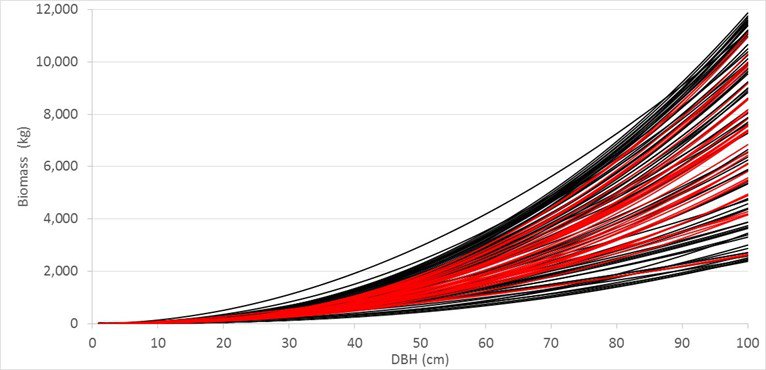New Carbon Equations and Methods, 2021
New carbon equations and new process to estimate carbon storage and sequestration using wood density.
Tools Affected and Version that the Changes were Implemented in: Design (v. 7.0), Eco (v. 6.0.22), Forecast (in Eco v. 6.0.22), MyTree (v. 2.5.16), and Planting (v. 2.1.2)
Why the Change: To add more international species equations; increase the number of base equations for carbon estimates; improve species carbon estimation via wood densities; finalize carbon equations, which will allow us to “lock down” these equations to aid in carbon monitoring and reporting
Details About the Change: Eighty-three new carbon equations from across the globe that are in the GlobAllomeTree (2017) database were added. Not all carbon equations are used from this database. Only equations that produced whole tree carbon estimates within 2-12 tC at 100 cm dbh were selected in order to remove outliers (Figure 1). Wood density data were added to the i-Tree database from the Global Wood Density Database (Chave et al. 2009, Zanne et al. 2009) and McPherson et al. (2016). The new carbon equations and wood density data will produce carbon estimates based on more equations and a process of weighting wood densities between the actual species measured and the species equation used:
Cest = Ceq x WDspp / WDeq
Where Cest = Carbon estimate, Ceq = carbon estimates derived from equations, WDspp = wood density of the species measured and WDeq = average wood density from the carbon equations.

Figure 1. Estimates of dry weight biomass using various equations. Red lines are i-Tree splined equations, which are currently used; black lines are new global equations to be added to i-Tree. Carbon estimates are ½ of dry weight biomass. When trees are small, equations estimates do not vary much. For large trees (dbh = 100 cm (39.4 in)), estimates of carbon vary between about 1.2 tC to 5.9 tC, depending upon species equation. The equation estimates will not vary much for most estimates as most of the forest is typically less than 15.2 cm (6 inches). However, for the fewer large trees, the estimates can vary by maximum of 5 fold.
Additional i-Tree 2021 Science Change Resources
- Tropical Carbon Equations - webpage describing the new tropical carbon equations and methods integrated in i-Tree Eco v6.0.22 release
- i-Tree 2021 Science Changes Outline - Feb2021 - A (pdf) outline with brief descriptions and reasons for sciences changes integrated in the i-Tree 2021 suite.
- i-Tree Roundtable YouTube link - i-Tree Roundtable Jan2021 discussion with Dr. Dave Nowak and the i-Tree Team describing i-Tree2021 model updates.(set to start at updates discussion point 24:38)
References
Chave, J., D.A. Coomes, S. Jansen, S.L. Lewis, N.G. Swenson, A.E. Zanne. 2009. Towards a worldwide wood economics spectrum. Ecology Letters 12(4): 351-366.
McPherson, E.G., N.S. van Doorn, P.J. Peper. 2016. Urban Tree Database and Allometric Equations. Gen. Tech. Rep. PSW-GTR-235. Albany, CA: U.S. Department of Agriculture, Forest Service, Pacific Southwest Research Station. 86 p. https://www.treesearch.fs.fed.us/pubs/52933
Zanne, A.E., Lopez-Gonzalez, G., Coomes, D.A., Ilic, J., Jansen, S., Lewis, S.L., Miller, R.B., Swenson, N.G., Wiemann, M.C., Chave, J. 2009 Data from: Towards a worldwide wood economics spectrum. Dryad Digital Repository. https://doi.org/10.5061/dryad.234